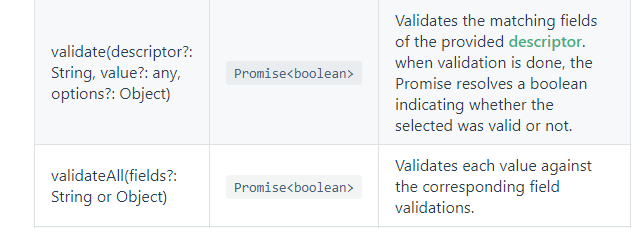vue+VeeValidate 校验范围(部分校验,全部校验)
搜索很久,没有发现有关于vue+VeeValidate部分校验的。自己写一个。
主要是两个场景: 1. 校验范围内,所有的字段。 2. 校验全局所有字段。主要方法: 1.validate(fields, scope) 2. validateAll(fields)
场景: 遍历得到多个列表,每一个列表都可以独立保存当前列表。在保存当前列表的时候,需要校验当前列表输入框的合法性。
代码:

<div class=" col-xs-12 col-md-6 col-lg-4" v-for="(p1,index) in carList" :key="index"> <div class="box box-success" style="margin-top: 15px;overflow: hidden;" > <div class="col-xs-7" style="border-right:1px solid #eee;padding-top: 10px;"> <label class="col-xs-12 " style="padding: 5px 0;">车牌号: <span style="font-weight: normal;word-break:break-all;">{{p1.planLicenseNo}}</span></label> <label class="col-xs-12" style="padding: 5px 0;;">司机:<span style="font-weight: normal;word-break:break-all;">{{p1.planDriver}}</span></label> </div> <div class="col-xs-5" style="padding-top: 10px;"> <div class="form-group" :class="{'has-error': errors.has('licenseNo' + index, 'newsletter' + index)}"> <label >实际车牌号 <i class="errMsg">*</i></label> <input type="text" class="form-control" v-model.trim="p1.licenseNo" v-validate="{required: true}" :data-vv-scope="'newsletter' + index" :name="'licenseNo' + index" :data-vv-as="$t('pagefield.purchase.carCode')"> <span v-show="errors.has('licenseNo' + index, 'newsletter' + index)" class="help-block">{{ errors.first('licenseNo' + index, 'newsletter' + index) }}</span> </div> <div class="form-group" :class="{'has-error': errors.has('actualQty' + index, 'newsletter' + index)}"> <label >实际数量(头)<i class="errMsg">*</i></label> <input type="text" class="form-control" v-model.trim="p1.actualQty" :data-vv-scope="'newsletter' + index" v-validate="{required: true, decimal:2, min_value: 0, max_value: p1.planQty}" :name="'actualQty' + index" :data-vv-as="$t('message.quantity')"> <span v-show="errors.has('actualQty' + index, 'newsletter' + index)" class="help-block">{{ errors.first('actualQty' + index, 'newsletter' + index) }}</span> </div> <div class="form-group" :class="{'has-error': errors.has('actualWgh' + index, 'newsletter' + index)}"> <label>总重(kg) <i class="errMsg">*</i></label> <input type="text" class="form-control" v-model.trim="p1.actualWgh" :data-vv-scope="'newsletter' + index" v-validate="{required: true, decimal:2, min_value: 0, max_value: p1.planWgh}" :name="'actualWgh' + index" :data-vv-as="$t('message.weight')"> <span v-show="errors.has('actualWgh' + index, 'newsletter' + index)" class="help-block">{{ errors.first('actualWgh' + index, 'newsletter' + index) }}</span> </div> <div class="form-group"> <label>过磅单</label> <input type="text" class="form-control" v-model.trim="p1.weightNo"> </div> </div> <div class="col-xs-12 text-right" style="border-top: 1px solid #eee;padding: 10px 15px;"> <button class="btn btn-warning" @click="doSave(p1, index)">保存</button> </div> </div> </div>
* carList: [{}, {}]
* data-vv-scope: [type='string'] 属性的值的类型是 string,表示定义了一个区域,在校验的时候,通过属性值 让validator 可以找到当前应该校验的区域。
此时通过 验证器提供的方法validate(scopeName)就可以校验当前区域了。
doSave (obj, i) { var _self = this var validateScope = 'newsletter' + i this.$validator.validate(validateScope + '.*').then((result) => { if (result) { // 提交数据 _self.doSaveAfterCheck() } }) }
/*
errors.has(field, scope) 返回一个true / false
errors.has('actualWgh' + index, 'newsletter' + index)}" 表示验证区域是 data-vv-scope = 'newsletter' + index 验证的字段是属性 name ='actualWgh' + index
first(field,scope) 返回与特定字段关联或由选择器指定的第一条错误消息,前提是作用域将查找该范围内的消息,
*/
<div class="form-group" :class="{'has-error': errors.has('actualWgh' + index, 'newsletter' + index)}">
<label>总重(kg) <i class="errMsg">*</i></label>
<input type="text" class="form-control" v-model.trim="p1.actualWgh" :data-vv-scope="'newsletter' + index"
v-validate="{required: true, decimal:2, min_value: 0, max_value: p1.planWgh}"
:name="'actualWgh' + index" :data-vv-as="$t('message.weight')">
<span v-show="errors.has('actualWgh' + index, 'newsletter' + index)" class="help-block">{{ errors.first('actualWgh' + index, 'newsletter' + index) }}</span>
</div>
场景2 : 页面有多个校验。当保存的时候,需要全部校验。这个场景官方提供2种方法.
this.$validator.validate().then((result) => { if (result) { // 提交数据。
// result是一个boolean值。true 表示没有触发错误规则,false 表示页面有非法值,触发错误 _self.doSaveAfterCheck() } })
this.$validator.validateAll().then((result) => { if (result) { // 提交数据。 _self.doSaveAfterCheck() } })
上述两种校验全部的方法不同点在于适用场景:

validate() 可以指定校验范围内,或者是全局的 字段。而validateAll() 只能校验全局。
官方示例:
// validate all fields. // 校验全局范围所有字段 validator.validate(); === validateAll() 两个方法完全一样。 // validate a field that has a matching name with the provided selector. // 校验哪个字段? field 取name的值。 validator.validate('field'); // validate a field within a scope. // 校验 某个域内 的某个字段。 validator.validate('scope.field'); // validate all fields within this scope. // 校验 某个域内的所有字段。 上述例子就是用的这个。 *_* validator.validate('scope.*'); // validate all fields without a scope. // 校验没有定义域内的 字段。适用场景: 校验场景分为两种: 定义域的,没有定义域。
// 当页面所有需要校验的字段,都定义了域,则这个方法会导致没有可校验的值,直接返回true validator.validate('*');




 浙公网安备 33010602011771号
浙公网安备 33010602011771号